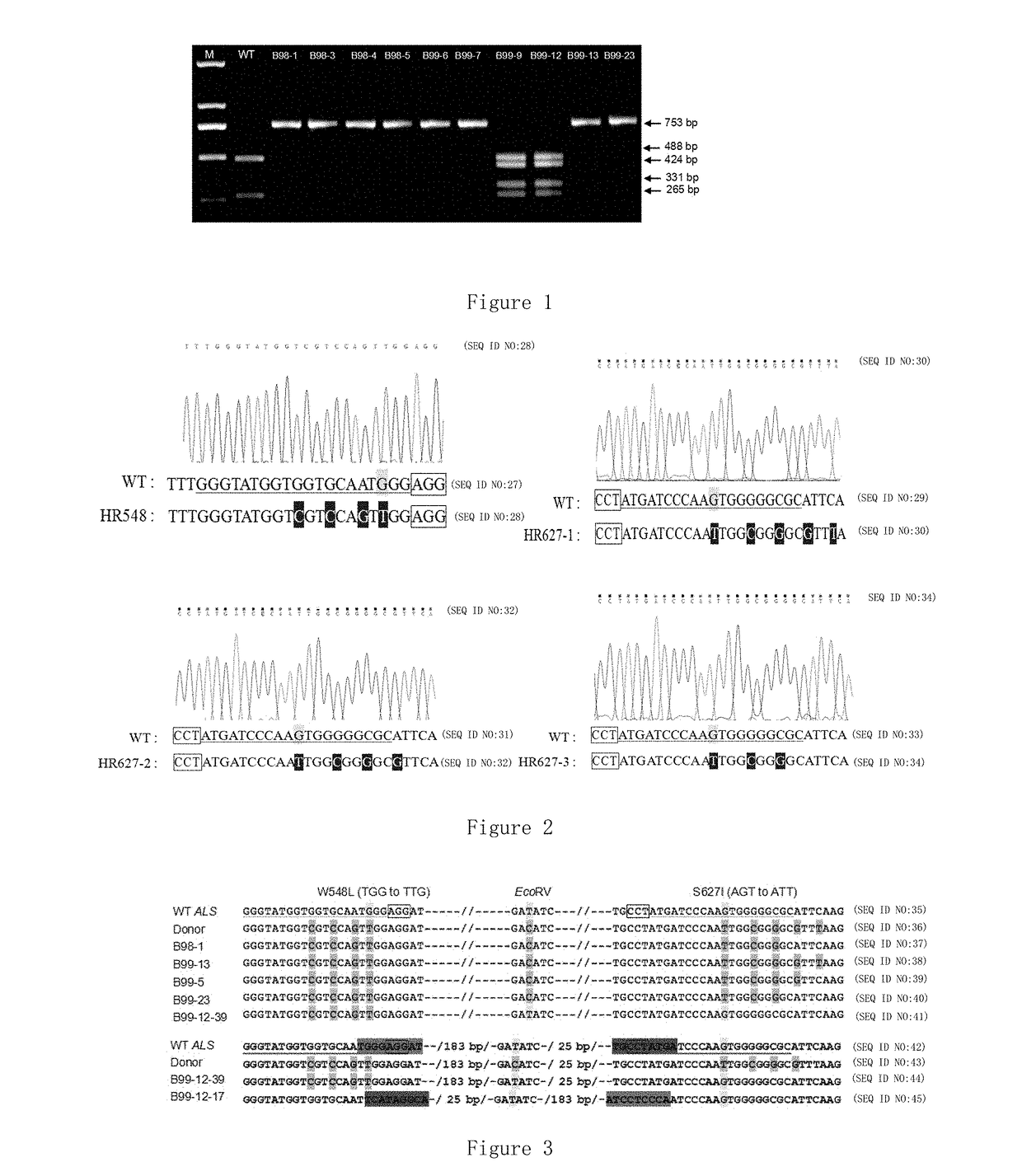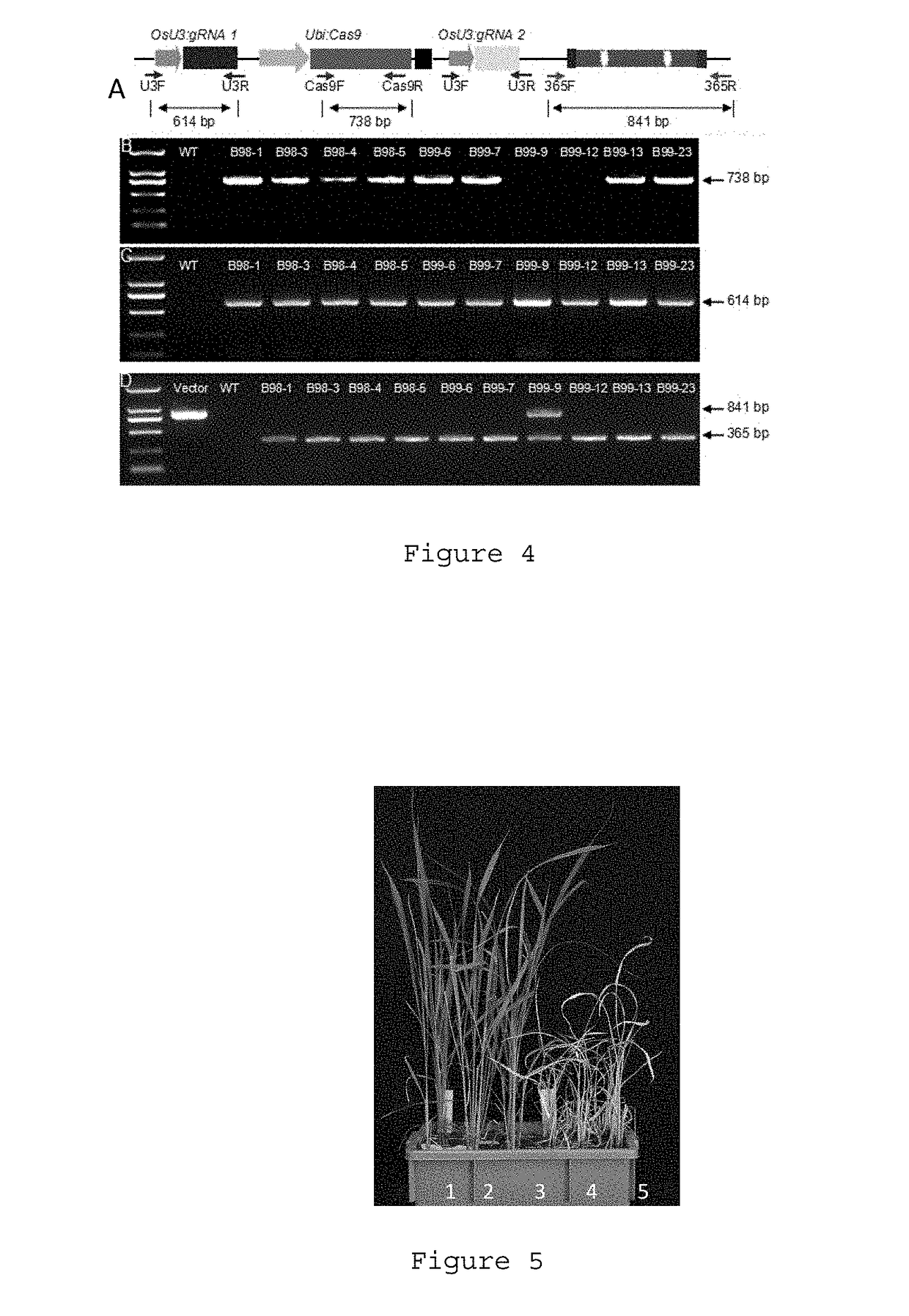System for site-specific modification of als gene using crispr-cas9 system for production of herbicide-resistant rice and use of same
a technology of site-specific modification and als gene, which is applied in the field of gene engineering, can solve problems such as plant death, site-specific modification studies, and amino acid replacement or site-specific integration
- Summary
- Abstract
- Description
- Claims
- Application Information
AI Technical Summary
Benefits of technology
Problems solved by technology
Method used
Image
Examples
example 1
Construction of Vectors for Site-Specific Mutagenesis of Acetolactate Synthase (ALS) Gene
[0055]A double-stranded DNA molecule, as represented by the sequence of positions 7590-8051 from 5′-end of SEQ ID NO. 1 in the sequence listing, was artificially synthesized, designated as arm donor (donor DNA).
[0056]A recombinant vector, pCXUN-cas9-gRNA548-gRNA627-arm donor (a circular plasmid) was artificially synthesized. The recombinant vector pCXUN-cas9-gRNA548-gRNA627-arm donor is represented by SEQ ID NO. 1 in the sequence listing. In the SEQ ID NO. 1, the nucleotides at positions 900-7570 constitute a Cas9 protein expression cassette (the nucleotides at positions 5580-7570 constitute a Ubiquitin promoter, the nucleotides at positions 1446-5576 constitute a Cas9 gene, and the nucleotides at positions 900-1152 constitute a NOS terminator), the nucleotides at positions 261-747 constitute a gRNA expression cassette 1 (the nucleotides at positions 367-747 constitute a OsU3 promoter, the nucle...
example 2
Production and Confirmation of Rice with ALS Having Both Amino Acids at Positions 548 and 627 Site-Specifically Modified
[0057]I. Production of Site-Specifically Modified Rice[0058]1. Plump seeds of Nipponbare rice were selected and dehulled. After sterilization and washing, the seeds were uniformly dibbled into solid medium R1, and exposed to continuous illumination at 28° C. for 2-3 weeks to induce the formation of calli.[0059]2. Following step 1, the induced calli were treated with solid medium R1 containing 0.3M mannitol and 0.3M sorbitol for 4-6 h, to obtain treated calli.[0060]3. The recombinant vector pCXUN-cas9-gRNA548-gRNA627-arm donor and the arm-donor were mixed in a molar ratio of 1:20, and the mixture was used to bombard the treated calli obtained in step 2 by means of a biolistic (using gold powder of 0.6 μm, at a bombardment pressure of 900psi), to obtain transformed calli.[0061]4. After step 3 was completed, the transformed calli were cultured on solid medium R1 conta...
PUM
| Property | Measurement | Unit |
|---|---|---|
| Electrical resistance | aaaaa | aaaaa |
| Molar ratio | aaaaa | aaaaa |
Abstract
Description
Claims
Application Information
 Login to View More
Login to View More - R&D
- Intellectual Property
- Life Sciences
- Materials
- Tech Scout
- Unparalleled Data Quality
- Higher Quality Content
- 60% Fewer Hallucinations
Browse by: Latest US Patents, China's latest patents, Technical Efficacy Thesaurus, Application Domain, Technology Topic, Popular Technical Reports.
© 2025 PatSnap. All rights reserved.Legal|Privacy policy|Modern Slavery Act Transparency Statement|Sitemap|About US| Contact US: help@patsnap.com


